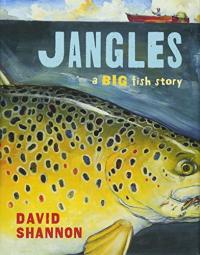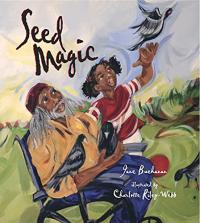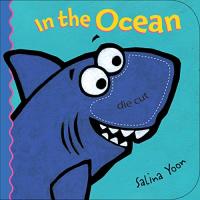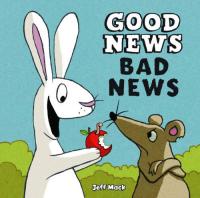
John Chapman, better known as Johnny Appleseed, changed his world “seed by seed, deed by deed” as this handsome book encourages readers to do. Children are encouraged to celebrate Johnny Appleseed’s anniversary every autumn by planting seeds literally and figuratively.
Seed by Seed: The Legend and Legacy of John “Appleseed” Chapman

An observant girl shares her observations and appreciation of ducks as she and her mother walk and watch. Information appears on open pages that sport informal illustrations and lively language for a memorable look at these feathered delights.
Just Ducks!

Jangles is the fish of legendary proportion. He’s evaded everything from special lures to dynamite from fishermen on Big Lake. The narrator shares his father’s story about Jangles, realistically illustrated in deeply hued colors for a fish tale of gigantic proportion.
Jangles: A Big Fish Story

Lydia tires of her electronic devices while her parents and brother are enmeshed in theirs. A small leaf beckons the girl outdoors, propelling her into an imaginative outdoor adventure. Sure to start conversations among plugged-in family members, this genial fantasy is playful and light.
Hello! Hello!

Animal tails have different uses. A scorpion’s tail is used to sting its prey while a beaver uses its tail to navigate in water. A close-up of a tail and the titular question is followed by a picture of the animal and its tail in action for a playful but edifying book.
Who Has This Tail?

The rescue and return to the wild of an orphaned moon bear (aka Asiatic black bear) is documented in clear language and action-paced photographs. A map of Yasha’s homeland as well as a note from the scientist who worked with her and additional resources are included.
Saving Yasha: The Incredible True Story of an Adopted Moon Bear

Textured collage and paint illustration and various poetic forms are used to introduce creatures that live in difficult, dangerous places. Ice worms in “Frozen Solid,” for example, “…If lurking in the deepest seas,/Why not between the glacial ice,/helped by their own antifreeze?”
A Strange Place to Call Home

Snakes are presented through up-close and personal image and text for and engaging, informative look at a host of colorful and handsome reptiles. The photographer, also a biologist, concludes with insight into his experiences photographing the sometimes uncooperative subjects.
Snakes

Stunning full-color photographs and crisp text introduce plants that gain nutrients by capturing unsuspecting insects and small animals. Locations where they grow are placed on maps, brief experiments, and additional resources conclude this engaging look at hungry plants.
Meat-Eating Plants: Toothless Wonders

The benefits of human actions to help bat survival are introduced in this readable, realistically illustrated and well-sourced introduction. A variety of bats are included with their range identified on clear maps.
A Place for Bats

Two people in bright, stylized garb sail to the islands known as the Galapagos. On successive days of the week, they see a variety of the animals that live there with the repeating refrain, “We’re sailing to Galapagos….I wonder who we’ll see.” End notes describe in greater detail the location and inhabitants of the Galapagos as well as a brief piece about Charles Darwin who sailed there.
We’re Sailing to Galapagos: A Week in the Pacific

Julianita is excited to receive her very own caterpillar to raise at school! Yet when her caterpillar, Tiger, finally emerges from his chrysalis, Julianita doesn’t want to let him go. She worries that he will get lost on his way to Mexico. “Tiger knows the way to Mexico because it’s in his heart,” her Abuelito reassures her. She feels sad to see Tiger fly away, but Julianita knows that someday, she will follow him to back to her grandfather’s beloved homeland.
Butterflies on Carmen Street

Autumn is a season during which there are many changes: leaves turn colors, air becomes cooler, and crops are harvested. These and more seasonal signals are presented in conversational language and vivid photographs. Easy-to-do autumn activities conclude this attractive and appealing book.
Awesome Autumn

A spiffy fox and friends and the alphabet are used to introduce apples — from blossoms, to how they grow, apple varieties, and more. Rich words (such as “deciduous”) are used, briefly but effectively introducing sophisticated concepts. Back matter extends the fun, activities, and information.
Apples A to Z

Single words in apple red combine with bold black-lined illustrations to tell tales of apples, autumn, seasons, and more. A brief note about apple trees and composting conclude this unique and attractive look focused around one of fall’s favorite fruits.
Apple

A girl and her family enjoy the pleasures of a summer day, capturing its colors, sounds, and tastes. The girl and her parents have a picnic in the park before night falls with its own special sights and sounds. Soft illustrations and rhyming text combine for the satisfying story until [I] “Turn off the light…/And dream of summer day…and nights.”
Summer Days and Nights

Children tease “crazy old Birdman” who feeds the pigeons in the park. That is, until he helps Rose discover beauty in the city and the color of flowers from simple seeds on her windowsill. Suddenly Rose finds a “singing garden” to brighten the gray city. Luminous illustrations swirl across the page to enliven the staccato free verse.
Seed Magic

Colorful sea creatures — from a sea snail and a sea horse, to coral and seaweed — are presented in this small, sturdy book. Single words accompany dark-lined, boldly colored illustrations with glittery paper cleverly incorporated with die-cuts.
In the Ocean

Good news: rabbit has a picnic to share with his friend mouse; bad news: it starts to rain. So it goes — good and bad events — until mouse is overwhelmed by the bad news, hurting rabbit’s feelings. The duo reconciles, which is “very good news.” Understated text and simple illustrations enliven the series of improbable events for a comical picnic.
Good News, Bad News

Outdoor adventures await adults and children throughout the year. Illustrated, easy to follow instructions and a can-do approach are sure to inspire readers of all ages to learn as they choose from a range of games and activities with background information included.
Get Outside: The Kids Guide to Fun in the Great Outdoors

Many different types of frogs, frog lifecycles, etc. are presented through brief but illuminating information and highly realistic watercolors. A concluding note about the impact of humans on frogs, insight into the author’s interest and additional resources conclude this handsome and engrossing look at this animal.
Frogs! Strange and Wonderful

A child and her family plan and plant a garden and observe it as it grows. Her narration includes information about the process while conversations between two hens add humor and information. The appealing, light-lined, cartoon-like illustrations vary format while adding information and wit.
Secrets of the Garden

Two children start to plan their community garden while snow is still on the ground. Come spring they “plant a little seed or two…or more” and wait. They work and wait until the harvest and enjoy the fruits (and vegetables) with neighbors. Illustrations in vivid color and strong line paint the garden, its visitors, and the dedicated gardeners.
Plant a Little Seed

The prairie is home to lush and unique plants and animals. Here they are introduced in the cadence of a familiar rhyme (“Over in the Meadow”) which is followed by brief factual information. All is accompanied by eye-catching, textured mixed media illustrations that inform and engage.
